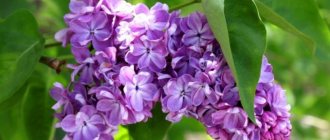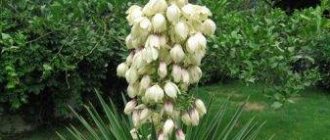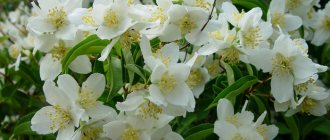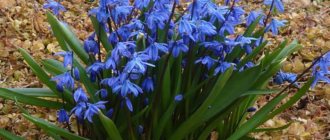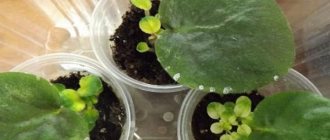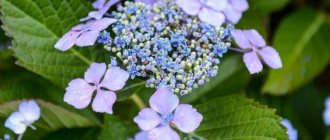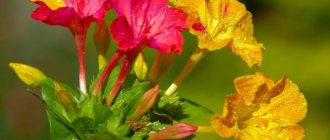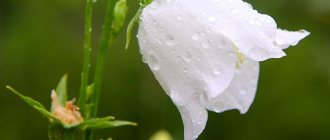Lilac is a beautiful flowering shrub of the Olive family. In late spring and early summer, this plant blooms magnificently with large inflorescences growing at the ends of the branches. Pale violet, violet, lilac, white panicles consist of small tubular flowers with four petals. Dutch breeders have developed the Primrose variety, which produces delicate yellow inflorescences.
The habitat of wild lilac is southeastern Europe, China, regions of Asia with a temperate climate. Currently, this shrub is planted throughout Europe and Asia. In Russia, lilacs decorate city parks and alleys, summer cottages and front gardens.
Shrubs and subshrubs, flowers similar to lilac, have dozens of varieties and species. They belong to different families and genera.
Description
The ornamental garden plant Lagerstroemia indica grows well in the Mediterranean, in the south of Ukraine and Russia. A deciduous shrub or tree is covered with many “corrugated plates” of various colors and shapes, collected in dense tassels.
The leaves are simple, with full margins, different sizes 5–20 cm, oval, elliptical. In autumn, the green leaves turn gold, orange, red or purple before falling. Some varieties have dark burgundy and even almost black leaves.
The flowers are 2.5 cm in circumference, with wavy edges, and are a panicle of ruffled flowers with a crepe texture. The colors are white, pink, raspberry, lilac, red and almost every shade in between. While there is no such thing as orange, yellow or pure blue, there is still a tendency towards the blue end of the spectrum.
Lagerstroemia grows well in the southern regions of our country
Lagerstroemia lilac has a wiry, grooved stem and spotted branches due to peeling bark. In Crimea, it can withstand frosts down to -10°C, provided that the shoots have time to become lignified. In hot, dry summers, the plant needs to be watered regularly. Grows best in fertile, well-drained soils and does not tolerate salinity. Tall trees reach 25-30 meters.
Sometimes lagerstroemia grows to the size of a tree
All diversity is divided into:
- Species: Inflorescences are looser than those of varietal ones. The leaf is long, oblong, pointed. The crown is branched. The smooth light bark of the trunk resembles coffee with milk.
- Varietal: with oval leaves and dense, dense inflorescences of rich colors. For example: Red Rokket - with bright scarlet inflorescences.
Cherry Dazzle - translated as dazzling cherry, also red. Short. The leaves are small, bronze, then darken, turn green, and turn red in the fall. Small flowers with round frilly petals are collected from pink and red inflorescences.
The crown of the variety is dense, self-branching. The branch, stopping in growth, sends out shoots from all the axils, and the plant turns out to be as thick as a Christmas tree. And it is noteworthy that each one grows with a bend to the side. The variety is not afraid of disease and drought.
Lagerstroemia Cherry Dazzle
Phlox paniculata
Phlox is a herbaceous perennial of the Sinyukhov family. The erect stems of the plant reach a height of 150 cm. Paniculate phlox is similar to lilac with its long inflorescences growing densely on each stem-peduncle.
The flowers of the plant are colored pink, lilac, purple, red, and there are many varieties with two-color petals. The habitat of wild phlox is southeastern North America (except Florida).
Learn more about garden perennials - phlox.
Types and applications
There are more than 25 species. Most grow in China, Korea and Japan. Lignified branches are super-strong and hard raw materials; they are used to make furniture and railroad ties. In its climatic zones, the plant is distributed in various types of landscapes; The leaves are used to feed larvae in the production of valuable Toscara silk.
Indian
The most common type, the shoots are thin, with a shiny, glossy skin. The leaves on the branches are attached to small cuttings. They are dark olive, dense, have a fleshy structure, round closer to the stem and pointed in the other direction. During flowering, they are practically invisible behind the lush inflorescences.
The inflorescences of densely growing flowers resemble a 20 cm pyramid. The buds resemble balls and gradually bloom from the bottom. In a flower of several wavy petals with a fringe of eyelashes, it blooms into a double miracle, reminiscent of a miniature rose. Bright yellow stamens are visible in the middle. The lush splendor of different flowers shower the bush. Has high adaptive abilities.
Lagerstroemia indica
Guilinensis
The shoots are thin and smooth. The leaves are small, rich green, shiny, about 6 cm. The leaf is wedge-shaped or rounded, the apex is pointed. The petals are one and a half centimeters white and grows on limestone mountain soil.
Lagerstroemia Guilinensis
Felt (tomentosa)
The branches are covered with a gray, fibrous layer of bark. Shoots and leaves have golden skin. The leaves are glossy and pointed. The petals are round, the color varies from white to pink and purple.
Tailed
The branches are smooth, with widely scattered leaves. They are located on legs measuring from five millimeters to a centimeter. The leaves are oval or elliptical, can be either bare or pubescent on the outside, up to 5 cm in size. The leaves are the same shape as the previous variety. The sepals are small, with a glossy surface.
Petals are white, oblong (1 cm). It blooms and produces fruits from early April to late October. This species is found in forests, forest edges, and hills. Other popular varieties of Lagerstroemia: Cordon Bleu, Dynamite, White Chocolate, Light Pink, Graceful Banaba.
All species need warmth, watering, good insolation and regular feeding. To give beautiful lines to a bush or tree, pruning should be done once a year. Domestic species urgently need a warm winter.
The inflorescences of caudate lagerstroemia are collected in peculiar tassels (tails)
Names of plants similar to lilacs
There are many plants that not everyone can distinguish from a lilac bush.
But we will look at the most popular among flower growers and gardeners:
- Hyacinth. One such plant is hyancinth. This flower comes from the Asparagus family. It is the haincinth flowers that resemble lilacs in shape and color. Hyancenth flowers are slightly larger. They come in white, pink, blue and light blue shades. The leaves of the plant are long and dense, different from the leaves of lilac. Hyancenth is not a shrub. It is often grown in pots on the windowsill.
- Jasmine is also a plant similar to lilac. The shape of its flowers resembles a star. The flowers themselves emit a very rich and bright aroma. The plant comes from India. This is interesting! Jasmine is often called the “king of all flowers.” Jasmine is actively used in cooking. We all know the aroma of jasmine tea.
Reproduction
- The seeds are sown in moist soil to a depth of about a centimeter and covered with a glass or film cap. This is done at an ambient temperature of at least 24 ° C, and full sunlight is also needed. Periodically needs watering and ventilation.
After two weeks, sprouts will appear from the soil. Afterwards they are planted in pots. Sprouts obtained in this way lose their varietal qualities during cross-pollination, so Lagerstroemia seeds must be purchased in specialized stores, research institutes, and private breeders.
It is possible to grow lagerstroemia from seeds
- Cuttings are separated in the spring. The lignified shoot is cut from the trunk and placed in a mixture of peat and sand. Several branches are planted in a pot at once. The dishes with cuttings are covered with a transparent bag and ventilated from time to time. The first roots will appear within 20 days.
- Division. Basal shoots are separated from the mother plant in the spring during replanting. The main thing is that he has already acquired his own roots. Planted in a light substrate, slightly moistened and placed in a warm, shaded place. When the plant gains strength, it is transferred to a permanent place.
Interesting facts about lilacs
Lilac is a long-liver. She lives more than 100 years. Lilac oil is worth more than the price of gold.
It is interesting that in nature there are like plant counterparts. And many are not always able to distinguish one plant from another. Flowers can be very similar to each other in size, color, and inflorescences. But at the same time, they most likely belong to completely different species and families. And this is truly amazing.
Lilac is no exception. This plant also has so-called doubles. There are different plants that are sometimes confused with lilacs, or have many similarities. This article will look at the plants that are most similar to lilacs.
Home care
Lagerstroemia requires careful care, otherwise the flowering will be weak and short-lived. In addition, the pet needs rest - if it does not shed its leaves, it will not gain strength by spring. Compliance with the watering regime is one of the most important conditions for caring for Indian lilacs.
You can’t overdry it, otherwise it will drop its buds, and if you don’t water it for a long time, it will drop its leaves. And vice versa, in the case of flooding, mold appears, which is harmful to the plant. It is recommended to water once a day, and twice in the summer, spraying if necessary. When the growth period ends, watering is reduced.
In winter, maintain soil moisture so that it does not dry out. When the plant is watered, it is transferred to a warm place for one to two hours. You need high-quality water, soft and free of impurities. If possible, the water is filtered; if not, it is recommended to stand.
If the air in the room is dry, the foliage is sprayed every day, in the morning or evening. The procedure is carried out during the cold period, if the plant has not lost its leaves. During the period of growth and development, room temperature is ideal for the oriental beauty. In winter, you need coolness, about 10 ° C.
An insulated loggia or veranda on the southeast and southwest sides is well suited - the plant needs a lot of light. In the shade, the shoots will stretch out and flowering will deteriorate. Lagerstroemia tolerates short-term frosts down to -5°C on the balcony and up to -10°C outside.
Shrub similar to lilac: mock orange
Common lilac description
Many people call this shrub garden jasmine because of the similar aroma of the flowers. Hybrid varieties are of greatest interest for use on your land plots.
The signature French varieties Lemoine have high winter hardiness. Many varieties are very similar to lilacs with their flowers.
There are also interesting and promising varieties obtained by crossing the common mock orange and the low small-leaved one.
The flowers have a distinct strawberry scent: 'Manteau d'Hermine', 'Avalanche' and 'Mont Blanc'.
Among the large-flowered species are o (Pyramidal), "Alabasrite" (Alabaster) and "Enchantement" (Charm).
An important advantage of mock orange is its relative unpretentiousness. The main thing is to provide sufficient illumination and avoid drought or stagnation of water.
Chubushnik (traditional garden jasmine)
WE RECOMMEND WATCHING:
Trimming
The tree grows quickly, and inflorescences appear only on young branches. Therefore, pruning is done every year in the fall. The shoots are cut to 20–30 cm. If the plant is a tree, one developed shoot from the root is left, the others are removed. If a shrub is formed, there are several main shoots. Damaged, broken off, growing inward and thickening the crown are also removed.
Soil and fertilizing. Grows well in store-bought, all-purpose potting mix for flowering plants. The drainage layer is a quarter of the total volume. It is possible to create the soil for planting yourself - equal proportions: sand, turf and deciduous soil. The substrate must be loose - this is important! Fertilizers are applied during the period when the plant blooms. In the spring, liquid complex fertilizer and fertilizing are applied.
Transfer. On average, the plant is moved to another container in the spring every 2 to 3 years. The container for transplantation should not be too large, but high enough. A gentle way is to reload or renew the top layer of soil (it does not tolerate the procedure well).
RELATED MATERIALS
4,5
4
Lilac is an unusually beautiful and extremely diverse flowering shrub. Although growing...
4,25
In the age-old debate about which lilac is better to choose - grafted or own-rooted - for a long time...
4
Lilac can surprise us not only with the color of its flowers, but also its leaves, the unusual shape of its petals and...
4,33
1
In May, when all the gardens are buried in a “lilac fog,” rare, unusual lilacs beckon from afar...
5
If color is the first thing that attracts attention when looking at a lilac, then we begin to notice...
5
If you prefer your own root lilac, and the desired variety can only be obtained in the form of...
5
1
I don’t want to fall into pathos, but domestic varieties of lilac are truly our national treasure. ...
5
1
Lilac varieties, of which there are now more than one and a half thousand, differ in the color and shape of flowers and inflorescences. ...
4
8
Common lilac is familiar to everyone. But there are other types: some of them are already becoming...
5
11
Today on Sokol, where the famous lilac garden was, there is a dog walking area. And once upon a time...
5
9
Lilac varieties, of which there are now more than one and a half thousand, differ in the color and shape of flowers and inflorescences. ...
2
The traditional and most effective way to propagate varietal lilacs is grafting. Subject to...
Serezha March 17, 2013
5
Editorial December 18, 2013
1
Diseases, pests and problems
The eastern beauty is sick and rarely exposed to pests. The main pests for the plant are aphids and red mites. There is still a risk of exposure to mold and powdery mildew indoors. This is where fungicidal preparations come to the aid of gardeners. For preventive purposes, you need to regularly ventilate, water, and use a ventilated substrate.
Problems of gardeners when growing:
- Insufficient number of flowers and stretching of shoots due to lack of light, low temperatures, lack of rest in winter;
- Improper pruning will not produce inflorescences;
- Falling leaves and flowers in summer means lack of moisture;
- If it died, it was due to excessive watering, dry soil, or low temperatures.
Skimmia
This plant of the Rutaceae family is a perennial shrub. Skimmia leaves are dense, wide, dark green in color. The plant produces lush spherical inflorescences; in August, red berries are formed from the flowers.
[adsp-pro-5]
Skimmia differs from lilac in the shape of flowers and inflorescences, as well as in the formation of berries. Decorative skimmia flowers are dark red, red, white, pinkish. The habitat of wild species is the mountain forests of southeast Asia and the Japanese islands.
Growing lagerstroemia in open ground
Lilac has amazing properties: the inflorescences change color; one plant can produce several shades at once. By dawn, the pleasant aroma of flowers intensifies. In order for lagerstroemia to bloom beautifully, you should adhere to the following rules:
The place should be very well lit. Other plants may suffer at such temperatures, but lagerstroemia is comfortable. Such active sun is necessary for lush flowering.
Ordinary black soil, for all its advantages, is not suitable. To achieve good growth, you need to mix the soil with sand. You will get the desired composition.
Warm winter. If the lilac grows in a tub outside, it is brought into a cool room after the leaves fall, where it is left for the winter. Watering once a month is acceptable.
In April-May, when it gets warmer, the plant is moved outside. If lagerstroemia grows in open ground , then by winter it is pruned, hilled and covered with spruce or sawdust. When the soil warms up enough, the shrub will begin to actively grow again.
Peculiarities
When different varieties of lilac bloom: how to force the plant in winter? When does lilac bloom, in what month?
Different varieties of lilac amaze with their diversity and many shades: delicate white, bright red, rich inky flowers delight the eye. But not all varieties are easy to care for, so a beautiful picture may remain a dream. The solution to the problem is standard lilac. A magnificent tree will decorate the garden and is relatively easy to care for. It has a number of advantages.
- An undoubted advantage of lilac is its thick, dark green foliage. Even a non-blooming tree looks beautiful.
- The inflorescence consists of many small flowers, which can be simple or double. The color range is very diverse and depends on the chosen variety. Light blue, red, burgundy and white flowers are more common.
- A tree formed on a trunk is more compact than a spreading shrub, and looks neat and elegant.
- Caring for a tree is much easier than caring for a bush, which tends to grow throughout the entire area. By grafting a tree with different types of lilac, you can grow an exclusive specimen.
- Lilac leaves retain dust very well.
Advantage of cuttings
Lilac cuttings have advantages over other options for obtaining ready-made bushes. When using seeds yourself, difficulties may arise, since they do not always germinate easily.
Purchasing seedlings leads to additional costs, so taking lilac cuttings will also be a profitable option. If you understand the intricacies of planting using other methods, you can choose any one. Any method requires careful preparation and step-by-step procedures. Don't forget about maintenance, which should be regular.
Eucalyptus
The plant is a small pyramid-shaped tree. The surface of the leaves is smooth, shiny and green-blue in color. Young eucalyptus has oval soft leaves, but with age they stretch out and become dense. The flowers are small, solitary, and the fruits are in the form of a box.
Eucalyptus smells very strongly, its smell is spicy, fresh, similar to camphor. For this reason, you should not place it in a children's room or bedroom. The flower is able to secrete phytoncides, which disinfect bacteria in the air and prevent the development of diseases of the throat and respiratory system.
A subtropical evergreen plant that takes root well at home. Its leaves have an elongated shape and can be up to 4 cm in width. Laurel loves sunlight, good watering and warmth.
All parts of the plant contain essential oil, resins, tannins and bitterness. Thanks to this, laurel has a specific aromatic smell and a pleasantly bitter taste.
The aroma of the flower is useful for intestinal spasms and inflammation of the respiratory tract. It freshens the air and repels insects.
Choosing a cutting
Before you learn how to grow lilac from a twig, you should choose the right cutting - it depends on whether the shoot will take root or not. The branch must be cut carefully. This should be done in early spring, when the cutting is not yet actively growing, otherwise it will be difficult for it to take root.
It is necessary to cut green branches of medium thickness. A cutting from the crown of a young bush, preferably from the middle, is perfect. It will be possible to grow a bush if there are 2-3 nodes and small internodes on the branch. It is advisable to cut cuttings early in the morning - they will take root better.
Names of plants similar to lilacs
There are many plants that not everyone can distinguish from a lilac bush.
But we will look at the most popular among flower growers and gardeners:
- Hyacinth. One such plant is hyancinth. This flower comes from the Asparagus family. It is the haincinth flowers that resemble lilacs in shape and color. Hyancenth flowers are slightly larger. They come in white, pink, blue and light blue shades. The leaves of the plant are long and dense, different from the leaves of lilac. Hyancenth is not a shrub. It is often grown in pots on the windowsill.
- Jasmine is also a plant similar to lilac. The shape of its flowers resembles a star. The flowers themselves emit a very rich and bright aroma. The plant is native to India. This is interesting! Jasmine is often called the “king of all flowers.” Jasmine is actively used in cooking. We all know the aroma of jasmine tea.
Common lilac (Syringa vulgaris)
This lilac is found everywhere. The shrub grows up to 5 m in height and up to 2 m in width. Flowering is observed in May. In warm spring, the inflorescences bloom at the beginning of the month. Based on this species, many cultivated varieties have been bred: double, large-flowered, hyacinth-flowered, etc.
- Popular varieties with simple flowers: Amethyst (bluish-purple inflorescences), Red Moscow (dark purple), Galina Ulanova (white).
- Double flowers in varieties Victor Lemoine (dense purple inflorescences), Beauty of Moscow (white-pink flowers with mother-of-pearl), Marshal Vasilevsky (pink-purple inflorescences).
- Large-flowered inflorescences of the lilac Kremlin Chimes (red-lilac flowers), Monique Lemoine (double white flowers), Kolesnikov Olympics (double pink flowers).
- Varieties with unusual flowers: Sensation (purple petals with a white border), Primrose (lemon-yellow flowers), Mulatto (pinkish-coffee petals).
Common lilac flowers are collected in paniculate inflorescences and emit a pleasant aroma.
Watering
How to grow a bush from a lilac branch? To do this, it is necessary to ensure high-quality watering. After planting, the plant should be sprayed with a spray bottle and then shaded.
For several weeks, watering should be done 3-5 times a day. This is necessary to ensure the required humidity. Every week you need to spray a solution of potassium permanganate on the leaves to protect the plant from bacteria and fungi. It is best to cover with a bottle to retain moisture.
The plant requires high-quality care. Roots will appear on it after 2 months. After this, it is necessary to ventilate the plant, preferably in the evenings: remove the bottle from it for 1 hour.
Rooting of the plant occurs in autumn. If necessary, it can be transplanted to a place where there is a lot of light and fertile soil. You can improve conditions by fertilizing the soil with compost, humus, and wood ash.
Treatment
How to grow lilacs from a twig? How to make sure that the cuttings are well accepted? To do this, you need to process it efficiently: remove the leaves from the lower node, and then make an oblique cut using a sharp knife. It is advisable to use a grafting pruner.
This must be done carefully so that you do not get a cut at the internode. Next, shorten the leaf blades by half. Remove the tip of the shoot completely with a straight cut. After this, the cutting can be used for planting.
How to choose lilac varieties for long-term flowering
Lilac is loved by residents of Russian cities, and especially villages, for the beauty of its blooms, unusually pleasant aroma, unpretentiousness and stability in flowering. From mid-May to mid-June, lilacs of different types and varieties can delight their owners with the lush bloom of white and purple-bluish tassels in which its small flowers are collected. At this time, in calm weather, small towns, villages and villages are literally enveloped in their heady aroma. The only pity is that this riot of flowering lasts only a month. But if you choose the right types and varieties of lilac, then this period can be extended almost until July.
If you plant Amur lilac near your house, it will delight you with clusters of white flowers with a slight pink tint from the end of May or the beginning of June. Flowering in this natural species lasts about 20 days. The aroma is not similar to the aroma of common lilac flowers. It clearly has the smell of honey. Amur lilac is a tall shrub that can grow up to 10m in height. Its disadvantage is that it will begin to bloom only at the age of 9 years.
Hungarian lilac blooms around the same time. She is also a representative of a natural species native to southern Europe. Despite its southern origin, Hungarian lilac winters well in the Moscow region, is unpretentious and easy to care for. Blooms luxuriantly. The flowers naturally have a lilac-pinkish color, but there are options in the form of Hungarian lilac with white, pale lilac, and pink flowers of a reddish hue. The Hungarian lilac bush does not grow higher than 4 m, but it is very spreading and can occupy a decent area in width; this must be taken into account when planting. Flowering lasts approximately 20 days. The smell of its flowers differs from the smell of common lilac, it is more muted, and there is no characteristic “lilac” tint. The brushes in which small flowers are collected are looser, but at the same time longer than those of the common lilac. Visually, this lilac is inferior in decorativeness to the common lilac, but it blooms at a later date. Hungarian lilac has one quality for which it is loved by landscape designers. She doesn't give birth. A bush of this lilac, planted on a lawn, will retain the beautiful appearance of a slender and well-groomed bush without any pruning or special techniques. The trunks of this lilac do not become bare over time, like the common lilac, and for this quality the Hungarian lilac is often used to create hedges.
But hyacinth lilac, which is a hybrid of common lilac and another natural species, blooms two weeks earlier than common lilac. More than a dozen of its varieties are known, differing in flower color. All of its variants have different shades of purple. They may be paler or brighter, or have a reddish or pinker tint. The aroma of the flowers of this lilac differs from the aroma of common lilac, but is also unusually pleasant and strong. This hybrid is unpretentious to grow. The bush will not grow higher than 4m in height. Blooms profusely. This lilac is also suitable for creating a hedge.
And finally, common lilac, which has a large number of varieties with different options for flower color, their shape, height of the bush and flowering time, which also makes it possible to select several varieties with different flowering times. There are varieties of common lilac that bloom together with bird cherry. They are considered early varieties. But there are few such varieties. These are white lilacs of the Primrose variety with a yellowish tint, dark pink Mulatto lilac, white Flora, dark purple Congo, a variety of regular lilac color with a pink tint Marshal Vasilevsky, as well as pink varieties Fantasia and Fantasy. There are also a few late varieties. These include lilacs, which bloom in late May - early June. These are the variety with double purple flowers Charles Joly, the variety with purple flowers Sensation, the varieties with white flowers Miss Ellen Wilmott and Madame Abel Chantanay. The overwhelming majority of varieties bloom at the usual time for lilacs, differing only in the duration of the flowering itself.
They dug up lilacs in the forest, but it turned out to be a poisonous plant
Lilac (Syringa) is a common genus of shrubs of the Olive family, which, according to various sources, has from 10 to 36 species. We have selected the most popular ones.
Lilacs of any kind are incredibly beautiful during flowering (May-July). Its lush inflorescences with a large number of small flowers bloom every year, even if the bush is practically not cared for. This unpretentious plant tolerates the vagaries of the weather and the unstable climate of the middle zone.
In the garden, lilacs are used both in single and group plantings. It is also good in hedges. In addition, compact species look great in mixborders next to almost any plants.
- Where and next to what to plant lilacs: 4 ideas for a spectacular flower garden
Don't know in which corner of the garden to plant lilacs? This article will help you choose the right location for your aromatic plant.
Chinese lilac (Syringa chinensis)
This hybrid of common lilac and Persian lilac was bred in France in 1777. The shrub grows up to 5 m tall and is distinguished by drooping shoots, oblong-ovate leaves and fragrant lilac-purple inflorescences that bloom in May-June.
Popular varieties: Lilac (with lilac flowers), Saugeana (with purple-red flowers), Duplex (with semi-double lilac flowers).
No less popular. This type of lilac was not discovered in China, but in France. The plant is a natural hybrid. It was found by botanists in the botanical garden of Rouen. The name Chinese lilac can be considered essentially erroneous, since it resembles the Persian lilac. Against the background of small, pointed leaves, small pinkish-lilac flowers look tender, very beautiful, emitting a characteristic aroma.
Looking at lilacs, types and varieties in the photo, you can always notice specimens of Chinese plants. They can also be terry. In central Russia, Chinese varieties are likely to freeze if it is too cold. However, when there are no large temperature changes, she feels great. Chinese lilac blooms magnificently and early, and blooms for quite a long time - up to fifteen days.
Common lilac (Syringa vulgaris)
This lilac is found everywhere. The shrub grows up to 5 m in height and up to 2 m in width. Flowering is observed in May. In warm spring, the inflorescences bloom at the beginning of the month. Based on this species, many cultivated varieties have been bred: double, large-flowered, hyacinth-flowered, etc.
- Popular varieties with simple flowers: Amethyst (bluish-purple inflorescences), Red Moscow (dark purple), Galina Ulanova (white).
- Double flowers in varieties Victor Lemoine (dense purple inflorescences), Beauty of Moscow (white-pink flowers with mother-of-pearl), Marshal Vasilevsky (pink-purple inflorescences).
- Large-flowered inflorescences of the lilac Kremlin Chimes (red-lilac flowers), Monique Lemoine (double white flowers), Kolesnikov Olympics (double pink flowers).
- Varieties with unusual flowers: Sensation (purple petals with a white border), Primrose (lemon-yellow flowers), Mulatto (pinkish-coffee petals).
Common lilac flowers are collected in paniculate inflorescences and emit a pleasant aroma.
